Huawei Mate 40 Pro Review
Impressive hardware from Huawei
Verdict
Once again, Huawei produces a beautiful smartphone to appeal to the Google-avoiders and geeks who are up for some sideloading. If that’s you, the Mate 40 Pro’s expansive screen, rich design, nippy interface and excellent camera will leave you grinning from ear to ear. For everyone else, the Google-shaped potholes that become apparent across a typical day and the high price will likely result in one too many compromises to take the plunge.
Pros
- Great screen
- Excellent camera system
- Loud, expansive speakers
Cons
- No Google services
- Can get warm when gaming
- Ultra-wide camera could be wider
- Not available easily in the USA
Key Specifications
- Review Price: £1099.99
- 50Mp camera
- Kirin 9000 5G 5nm chipset
- 88-degree OLED display
- 66w charging
Huawei’s Mate 40 Pro is an expensive Android smartphone at £1099/$NA/€1200. Instantly, a bar is set: it has to include best-in-class features to justify the price. Huawei also has an extra hurdle to overcome – the lack of Google Play Services being one.
The implications of the latter are far-reaching: from game saves to WhatsApp backups, if you’re not coming from a Google-free phone already, you’ll have to rethink your mobile life.
However, if any phone is likely to encourage you to do it, the Huawei Mate 40 Pro would be it and this stands as one of best phones and best Android phones in certain respects.
While the Huawei Mate 40 Pro is available through retailers in the UK and Europe, it is not easily available in the USA.
Design
- The Mate 40 Pro is certainly distinctive
- Huawei’s largest mainstream flagship yet
- Very curved look
- USB-C for charging
Fans of big phones rejoice. If you were expecting the compact form of the Pixel 5, or the iPhone 12 mini micro-appeal, then you’re not getting it here. The Mate 40 Pro is Huawei’s largest mainstream flagship to date, measuring 9.1mm thick. The iPhone 12 Pro Max is 7.4mm thick by comparison. Despite the extra thickness here, Apple’s device remains heavier by about 15g, and both taller and wider. Nevertheless, it should provide you with a point of comparison.
From the front, the Huawei Mate 40 Pro brings back a strikingly curved ‘waterfall’ display, similar to that introduced on its predecessor, the Mate 30 Pro. Unlike the Mate 30 Pro, however, this time Huawei ditches the notch and brings back the physical volume button on the phone’s right side.
On the upper-left of the screen is a chunky pill-shaped cutout for the front-camera system, which also face-unlocks your phone, takes some of the best selfies around, and keeps the screen on so long as you’re glancing at it.
The Huawei Mate 40 Pro screen is book-ended by uniform bezels top and bottom, but the left and right bezels are virtually invisible owing to that curve.
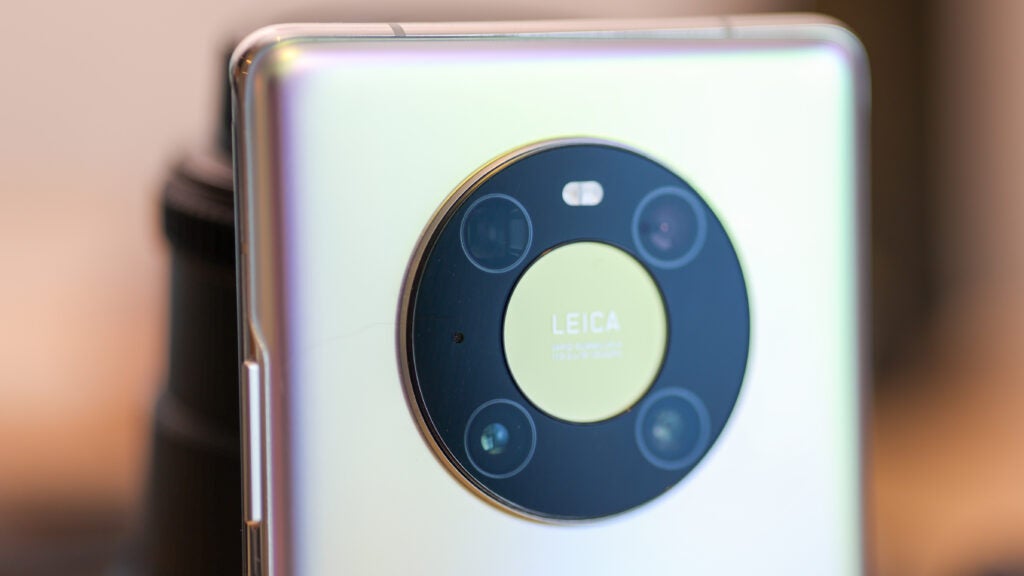
Along the phone’s bottom is a loudspeaker, a USB-C port and a SIM tray, which doubles up as a nano memory card slot. You’ll find all the buttons along the left edge, while up top is an infrared blaster and the second speaker.
Available in two finishes in the UK, the glass back of the Mate 40 Pro can be had in a matte, demure pearlesque Mystic Silver, or Black in the UK. In other regions, it’s also available in ceramic (black or white) and vegan leather (green or yellow) versions.
Huawei can be relied upon for excellent fit and finish. From the Mate 40 Pro’s polished metal frame, the assurance of IP68 water-resistance, through to the relatively smudge-proof matte glass back, everything looks and feels great. We also appreciate the phone’s bold styling, in-part a result of the circular camera system taking pride of place. With Leica branding sitting proud, alongside four cameras and a dual-LED flash, it’s clear that the Mate 4 Pro’s snapper means business before you even fire it up.
Screen
- 90Hz +456PPI: Great on paper but the Huawei Mate 40 Pro is stunning in the flesh
- Ticks all the boxes we look for in a display
- Very slim bezel
- Not quite the best display going, but among them
Sporting a 6.76-inch screen, the Mate 40 Pro’s display is a fraction larger than that of an iPhone 12 Pro Max. That said, it looks and feels much broader, owing to a more squat aspect ratio. Featuring slimmer bezels to the left and right than virtually any other device on the scene, it has a 94.1% screen-to-body ratio. That’s compared to the 12 Pro Max’s 87.4%, and the Galaxy Note 20 Ultra’s 91.7%.
The Mate 40 Pro’s screen also comes packing some decent specs. An OLED panel, with a 90Hz refresh rate and a 1344 x 2772 pixel resolution, the display here is as sharp as an iPhone with a pixel density of 456ppi. There are sharper panels to be seen in the Android camp, but once you go above 400ppi, additional clarity becomes much of a muchness.
Offering excellent viewing angles, colour reproduction, brightness levels and enjoyable-in-the-dark minimum brightness, there’s very little we’d change about the Mate 40 pro’s screen. While Huawei tends to lean towards the cooler side of the white balance spectrum, an eye-comfort mode warms things up nicely.
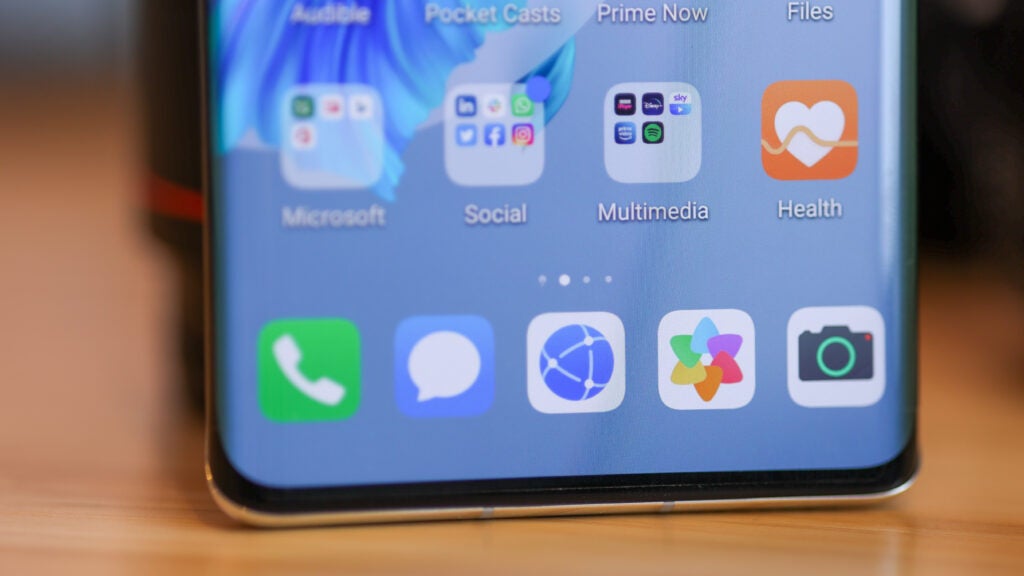
In addition, the 18.5:9 aspect ratio is a great middle-ground between the ultra-wide 21:9 movie aspect ratio of the Sony Xperia 5 II, and the traditional TV show aspect ratio of 16:9.
Responsive to the touch, loaded up with a pre-fitted screen protector and a pleasure to navigate, the only area we’d give the Mate 40 Pro a bit of a boost is that refresh rate. While still iPhone-beating at 90Hz, it’s just a smidgen behind the latest from OnePlus, Oppo and Samsung. You won’t notice the difference unless swiping side-by-side with a 120Hz phone, but it is noticeable once you do.
Performance and Google
- Ample oomph, storage and smarts
- No Google apps or services
- Instead there’s the App Gallery, which is still short of big UK apps
- Latest 5nm 5G chipset
The Mate 40 Pro is powered by a Kirin 9000 5G chipset – Huawei’s own brand of silicon. The Kirin 9000 is a 5nm octa-core chip that combines a high clock-speed core with three mid-level clocked cores, and four lower-clocked cores. The result, according to Huawei, is maximum power and maximum power-saving.
While popular benchmark apps don’t run on the Mate 40 Pro (an issue encountered on a number of phones from Motorola through to Nokia), it’s easy to confirm that when it comes to speed, the Mate 40 Pro presented no issues at all for gaming and general day-to-day use.
Playback in games such as Genshin Impact at highest graphics settings (60fps) was beautiful, with the huge screen joining forces with the wide open sound from the stereo speakers to deliver a fantastic open-world experience.
Genshin Impact is an example of a game that works well in this Google-free environment. It supports multiple login options – Twitter, Google, or a Mihoyo account – and so doesn’t require Google Play Games. If all titles were similar, then gamers wouldn’t be compromising with the Huawei Mate 40 Pro. However, other popular titles such as Injustice 2 that require Google Play saves won’t let you port across your game data from your old smartphone.
Also worth noting is that with intense games the Mate 40 Pro can become warm with long bouts of gameplay. I didn’t encounter heat management issues when using the phone for anything else – camera use or extended messaging, for example – and it’s better than the Galaxy Note 20 Ultra for gaming, but if you’re an avid player hankering after hours of action, it’s worth bearing in mind.
The Mate 40 Pro comes with 256GB of storage, as well as Huawei’s own nano memory card solution, so there’s ample space for all your files.
Despite launching a few months ago and running EMUI 11, the Huawei Mate 40 Pro still runs Android 10, which isn’t the latest version of Google’s mobile OS. However, this doesn’t really affect the UI you end up interacting with, given how heavily customised Huawei’s interface is.
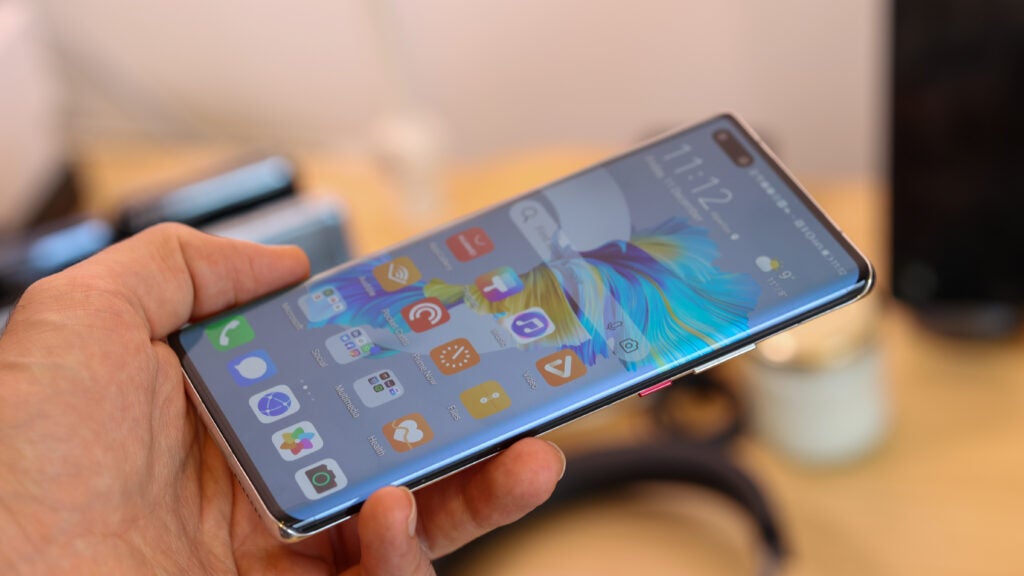
EMUI is great in some respects. The Mate 40 Pro’s is the best implementation of eye-monitoring, for example, so even if you put the phone down, so long as you’re looking at it, the screen will remain on. Look away, and it turns off.
Such eye smarts aren’t an isolated highlight. From knuckle-tap screen grabs to smart integration with Huawei laptops, EMUI is heavy, but it’s also very well thought out. You can even hook it to a TV or monitor for a desktop UI, similar to Samsung’s DeX system – and, in general, interaction with the phone is stable, smooth and feels fast.
That said, no matter how good EMUI is, the lack of Google services is an issue. What’s even more concerning for seasoned geeks is that it’s proving harder to hack Google services onto a Huawei device. Practically speaking, unless you’re actively trying to avoid Google, the Mate 40 Pro is going to be a series of insurmountable compromises sprinkled atop of an otherwise great smartphone.
The areas in which you’ll feel the lack of Google most are with Google’s apps: Google Docs, Drive, Meet and YouTube, to name a few. The extent to how far this reaches can’t be overstated. For example, WhatsApp backups use Google Drive, so you won’t be able to transfer old WhatsApp history onto your new Mate 40 Pro. I’ve covered game saves already – and, it goes without saying, if your business runs with Google for Business services, the calendar won’t integrate with the device calendar; Google Meet won’t work; and there’s no Docs editing for you, either.
Of course, there are workarounds – but when you’re spending £1099/$NA/€1200, do you really want to be faffing with hacks just so you can dial into a Google Meet conference call on your phone?
Camera
- One of the best camera phones of all time
- Typical high-quality Huawei cameras with excellent low-light performance
- A look akin to Leica cameras
- Stable video at 4K
Huawei’s phones have been among the best camera phones around for a few years now, and in this regard nothing changes with the Mate 40 Pro. At the helm is a 50-megapixel f/1.9 camera; identical to the one included with the excellent Huawei P40 Pro Plus. Alongside it sits a P40 Pro-a-like 12-megapixel f/3.4 5x zoom periscope camera, and a 20-megapixel f/1.8 ultra-wide.
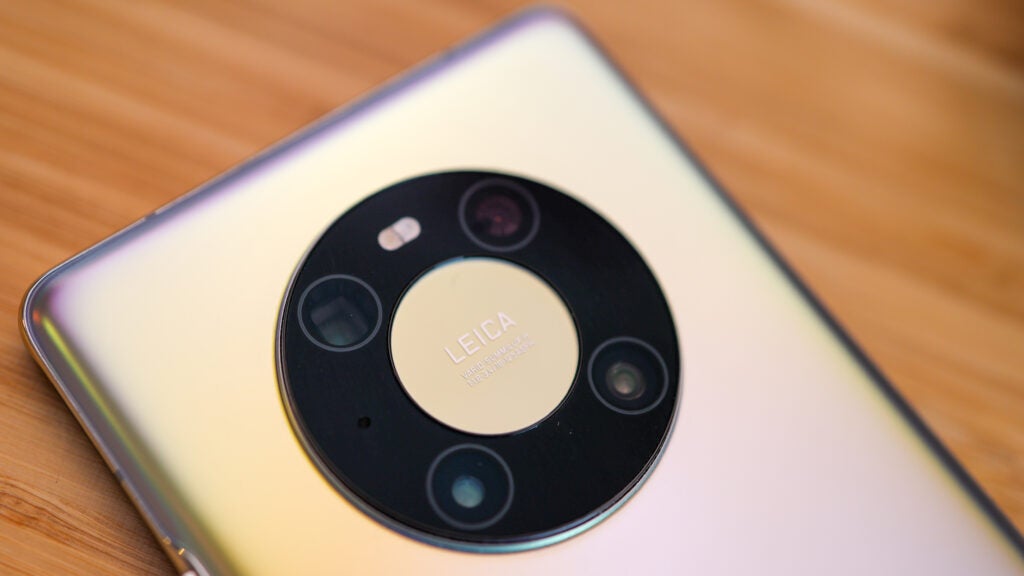
While most ultra-wide cameras are 13mm, the Mate 40 Pro’s focal length is 18mm, making it just a little wider than the 23mm main camera. This is unlikely to be a deal-breaker, but the similar focal lengths across cameras do hold back the system’s versatility. On the plus, the ultra-wide camera lens comes with manual focus and can grab macro photos, which is a boon.
As for pure photo quality, Huawei’s look is arguably Leica’s look, with photos taken on the Mate 40 Pro definitely exhibiting similar characteristics. Images are warm, rich and zingy, without looking mottled and over-processed like some photos taken on Samsung phones. As such, the majority will enjoy the balance the cameras achieve.


Detail is generally rich across all cameras, and while there’s no 10x optical zoom as found on the Galaxy S21 Ultra, in well-lit scenes, photos are usable up to around 30x zoom, which is incredibly impressive and you can see in the sample images below.
Dynamic range is strong even in backlit scenes, and challenging subjects such as black cats and glass look textured and realistic. Huawei’s Auto mode is also the best around when it comes to low-light photography, saving you from having to switch to Night mode.
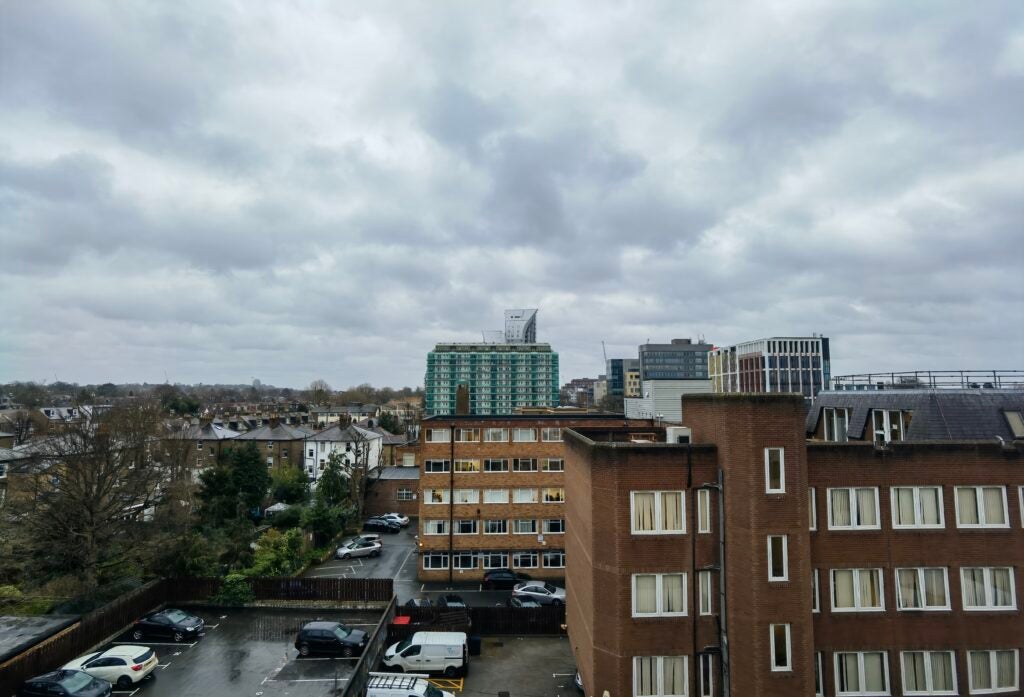
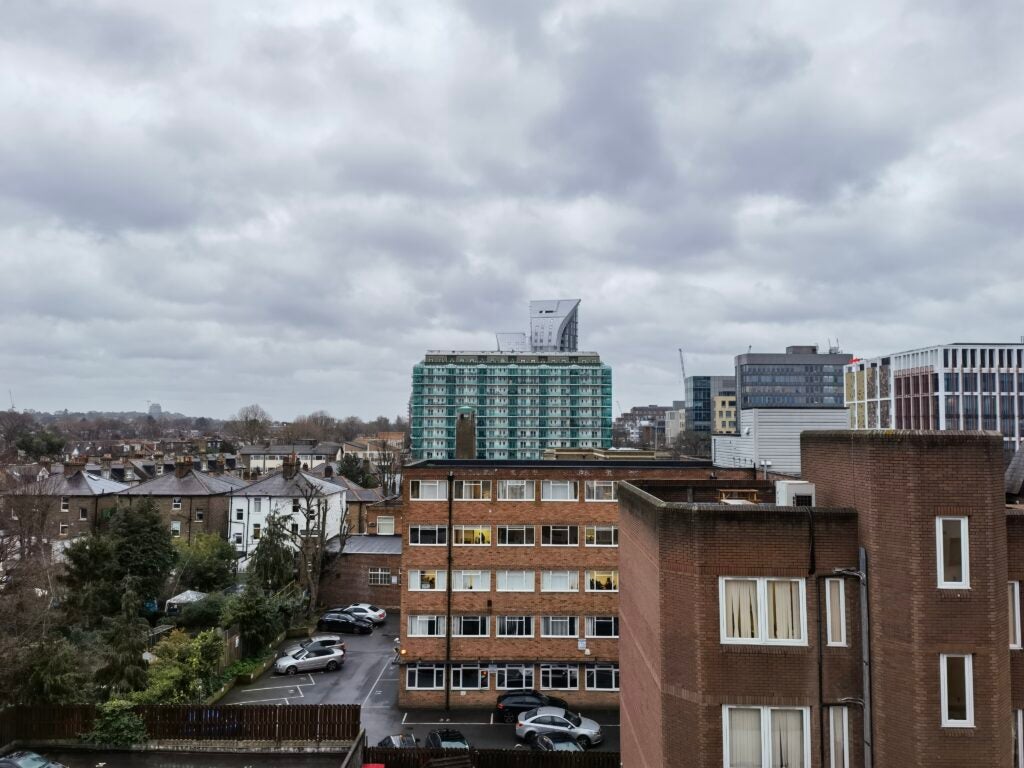


As for video capture, footage is shot primarily using the ultra-wide 20-megapixel camera, which Huawei refers to as the phone’s Cine Camera. With 4K resolution at a maximum of 60fps, the numbers are competitive, even if they can’t topple Samsung’s 8K-resolution Galaxy S21 series.
The results impress, though, with footage looking crisp, stable, and a nippy autofocus. The camera also grabs decent background blur when shooting close-up objects, something few smartphones can achieve in video. In middling light, the Mate 40 Pro holds its own, shooting with a softened image. However, as is the case with all smartphones, when the lights drop all the way, grain takes over.
The only camera phone we’d pick over the Mate 40 Pro in certain scenes is the iPhone 12 Pro Max, whose photos have a more muted, natural look that cinema-style fans will prefer.
That said, neither phone outperforms the other in every respect, and the Mate 40 Pro is probably the best across-the-board Android phone you can buy, alongside the P40 Pro and Pro Plus. What’s more, with a slew of manual modes and RAW capture available, there’s plenty here to appeal to enthusiasts who like to tinker.
Battery life
- Powers up quickly and the Huawei Mate 40 Pro lasts the day
- Lasts all day
- Very fast charging both wired and wireless
It isn’t surprising that the 4400mAh battery keeps the Mate 40 Pro going all day. It’s a decent capacity and Huawei has proven itself when it comes to power efficiency. More impressive is the speed at which it charges.
Wired, it powers up at 66W – a single watt faster than Oppo’s 65W Super VOOC 2.0. However, it’s with wireless charging that it takes the lead, with 50W Qi charging. Compared to an iPhone 12 Pro Max, it powers up at over three times the rate.
Should you buy the Huawei Mate 40 Pro?
You’ll struggle not to coo the second you pick up the Mate 40 Pro – and listening to its speakers boom as its screen sucks you in with crisp 90Hz video is sure to make you want one. Then there’s the camera – in fact, this is one of the best smartphones you can buy from a hardware point of view.
However, with a sky-high price of £1099/$NA/€1200, you’d be expecting close to perfection, and until Huawei devices support Google Mobile Services again, perfection won’t be the reality for most.
So, while we can’t recommend the Mate 40 Pro to the majority of readers, if you’re comfortable with the idea of ditching the big G, live in mainland China, or are confident in your sideloading skills and speak ADB fluently, the Mate 40 Pro has the potential to be a cracking phone.
FAQs
The Huawei Mate 40 Pro has an IP68 rating, meaning it is water resistant
Huawei currently does not sell phones through US carriers
In the UK, the Mate 40 Pro has an RRP of £1099


